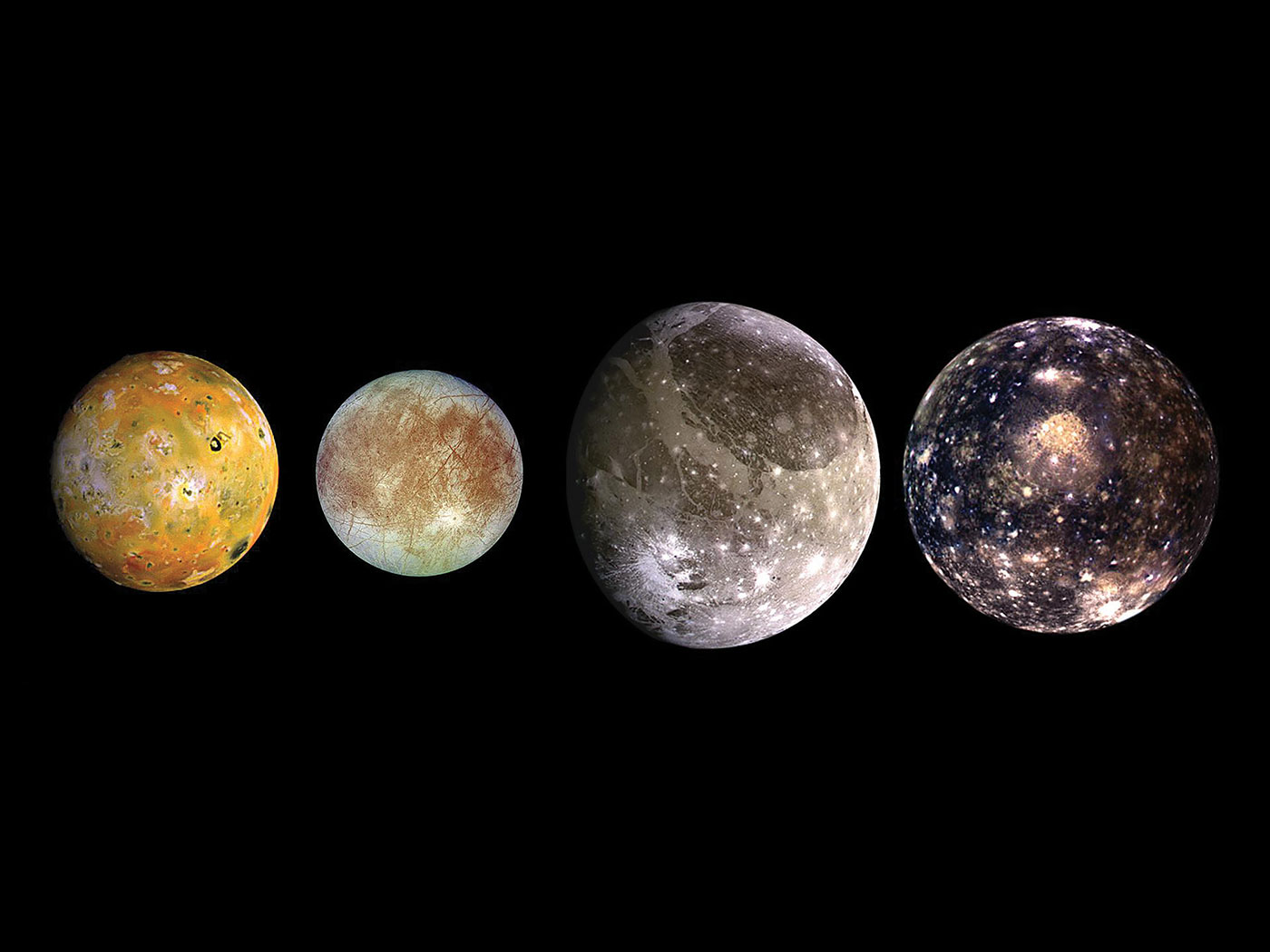Most astronomers accept the idea that stars form by gravitational collapse of a cloud of gas and dust, and that this process takes a minimum of 210,000 years.[1] The consensus is that it was the Big Bang that made all this possible. There are Christians who assert that the Bible can be harmonized with the Big Bang and this process of star formation.[2] Dr. Hugh Ross, an astronomer and minister, is the most prominent spokesman for this position. He postulates that the sun was formed before the earth and that it is wrong to view Genesis 1:14-19 as an account of the actual creation of the sun, moon, and stars. All God needed to do was to clear the cloudy atmosphere so that these celestial objects simply "appeared"[3] or became visible. E. J. Young, a Hebrew scholar, takes the opposite view: "That the heavenly bodies are made on the fourth day and that the earth had received light from a source other than the sun is not a naive conception, but is a plain and sober statement of the truth."[4] These interpretations are at odds with each other, so both cannot be true. At least one of them contradicts what God said in Genesis 1:14-19 concerning Day 4.
Throughout the Genesis 1 narrative God speaks and something happens as a result. These commands are characterized by the wording: "Let there be ___." One such command appears in verse 3 (light); two in verse 6 (expanse and divided waters); two in verse 9 (waters gathered and appearance of dry ground); one in verse 11 (sprouting plants); one in verse 14 (luminaries); two in verse 20 (sea creatures and flying animals); one in verse 24 (land animals); and one in verse 26 (man). All, with the exception of one, are used in the sense of God speaking to His creation. In the exception, one gets the sense of one member of the Godhead speaking to the others: "Let us make man." This command (i.e.: "Let there be ___") is known as a jussive.[5] God used this command consistently in the first six instances to refer to something brought into existence that did not previously exist. Regardless of whatever these commands signify, ex nihilo (out of nothing) or de novo (something new), they represent a fundamental change in the object that is "created." One may wonder since no clues in the text suggest another view, why in the command concerning the luminaries, Dr. Ross proposes something radically different:
The sun, moon, and stars are mentioned on the fourth day, and the opening sentence for the fourth day uses the Hebrew word "hayah"—"let there appear the sun, moon, and stars." So what the text is telling us is on the first day, the cloud layer was transformed from opaque to translucent so light could come through; on the fourth day, the clouds broke so that the observer on the surface of the ocean for the first time, could see the sun, moon, and stars.[6]
If this is truly the correct interpretation, then this exceptional command on Day 4 would represent the only non-creative command God issued in Genesis 1. All the other commands, as even Dr. Ross notes, are a creation of something that was not in existence before the command. We should ask: What is so exceptional about this command that requires such a radically different interpretation? It would appear, from reading Genesis 1, that each of God's commands brought something into existence that did not previously exist!
While the Hebrew language may seem frightening to some, it really is not. The style of writing of Genesis 1 is historical, using the waw-consecutive to express consecutive action (waw=and). Biblical historians use this style to: "express actions, events, or states, which are to be regarded as the temporal or logical sequence of actions, events, or states mentioned immediately before."[7] What this means for Genesis 1 is that God describes a sequence of events that occur one after the other throughout the creation week. We see this sequence reflected in the English as "And God said," "And there was," or "And it was," with which each verse in Genesis 1 begins. Each occurrence signifies that some action followed another in a real time sequence.
This is very important as it relates to the events of Genesis 1. Francis Andersen observes: "A string of WP (waw-consecutive) clauses in narrative prose (historical) stages events as occurring in a time sequence one after another. It is implied that one is finished before the next begins, so it is possible to speak of the verbs as 'perfective' in aspect."[8] So the events of Genesis 1:14-19 have an opening waw-consecutive "And God said," and a closing pattern of waw-consecutives "and it was evening, and it was morning" separating the 4th day from the previous and subsequent commands God issued. The point for the interpreter is that each day in Genesis 1 must be a completed event! So God began His creation of the sun, moon, and stars on Day 4 and finished them on that same day. This also rules out the concept that the days may overlap in some manner.
If the syntax and context suggest that God created the sun, moon, and stars in Genesis 1:14-19, how do those who maintain that they were created earlier argue their case? Dr. Ross would suggest that a key word in this passage is nathan, which appears in Genesis 1:17 translated "set." Here is how he defines this word: "set; put; place; appoint; bring forth; apply; ascribe; cause to appear; show."[9] The word, nathan, does have a broad semantic range, as Dr. Ross observes. However, its usage falls under three basic categories: "give, put or set, make or constitute."[10] In Genesis 1 God is establishing or setting the functions of these celestial bodies. However one may view the definition of nathan, it is not used with the signification "cause to appear."
The second word of importance is hayah. Dr. Ross defines this as "become; cause to appear or arise; cause to be made or done; come into existence; come to pass; make into something."[11] This word also has a wide semantic range, of which "to appear" is part. Yet, its basic meaning is one of existence: "It seems, however, that from the very outset, hayah was used to refer to 'being' in the sense of 'exist, be present' and of 'come into being, happen'."[12] If "to appear," as the sense that Dr. Ross suggests, is the interpretation of hayah in 1:14, then one must consistently apply this meaning in 1:3 (let light appear), and twice in 1:5 (let an expanse appear and let a dividing appear). These four occurrences must be interpreted in a consistent manner. But Dr. Ross does not do this. He interprets the word to mean "appearance" on Day 4, but interprets it to mean "come into existence" on all the other days.[13]
Those who believe that the stars were formed before Day 4 make a point from Hebrew syntax. Hebrew does not have a specific way of communicating a pluperfect tense. A pluperfect is: that which denotes that an action or event was completed before a given time. So, in Genesis 1:16, some would translate the first portion of the verse "now God had made the two great luminaries." The argument is that God made the stars before He created the earth, and now simply describes their function for the earth. Note Dr. Ross's explanation:
Now you'd also see in the fourth day it uses the word asah for the sun, moon, and stars, but it's in the past tense. God made—past tense—and it's in a parenthetical context after the nathan usage. Which means that it could have been made any time before.... There is only one past tense in the Hebrew, you can't tell if it's pluperfect or whatever.[14]
The point is that if "made" is pluperfect (i.e., had made) in verse 16, then it must be referring back to an earlier "making," but how much earlier? Some have proposed the events of verse 1 or verse 3, but it could just as well be simply referring back to verse 14.
The word "made" occurs two other times in Genesis 1. Each one could possibly be translated as a pluperfect, so if verse 16 is pluperfect, we would expect the others to be pluperfect also. But how does this effect our understanding of Genesis 1?
The first occurrence is on the second day (verse 6), when God said "let there be an expanse." Then we see in verse 7, "and God made the expanse." This should then be translated "and God had made the expanse." But this seems unnatural and contradictory. The other occurrence is on Day 6 (verse 24), when God said, "let the earth bring forth living creatures." Then we see in verse 25 "and God made (or had made) the beasts of the earth." Yet even if we accept the pluperfect tense in these instances, they are simply pluperfect to the previous command. The uses of "made" function as a description of what was accomplished as a result of His command. We can see this kind of function with other verbs in Genesis 1 that could be translated as pluperfects (verses 12, 21, and 27 are results of verses 11, 20, and 26). So what God made in verse 16 is clearly intended to be the same as that which God spoke into existence in verse 14. To conclude that the pluperfect refers to a long-ago, unrelated event, introduces meaninglessness into Scripture, and introduces a concept totally foreign to what God is telling us!
It would be useful to gain some insight from an early church father, Theophilus. He differs greatly from the views of Dr. Ross and the modern cosmologists as he says:
On the fourth day the luminaries came into existence. Since God has foreknowledge, he understood the nonsense of the foolish philosophers who were going to say that the things produced on earth come from the stars, so that they might set God aside. In order therefore that the truth might be demonstrated, plants and seeds came into existence before stars. For what comes into existence later cannot cause what is prior to it.[15]
It appears that Theophilus clearly understood the significance of this passage and would dispute current theories. We realize that when all the facts are discovered and rightly interpreted, science and Scripture will be in full agreement. Until that time, we must "take every thought captive" (II Corinthians 10:5) and make it obedient to Christ. The Bible is to be the standard for all thought! This means that we must not seek to insert foreign ideas into the Biblical text.
In the beginning of this article, we drew attention to two vastly different interpretations of Genesis 1:14-19. If current theories of the origin of the universe and star formation are correct, then the Bible is wrong. God did not say exactly how He created the stars, so we should attempt to build scientific models describing His actions, which utilize the best scientific data and that are consistent with Biblical revelation. The purpose of this article was to examine the Biblical data and determine what the Bible says about the creation of the stars. This article should be thought of as establishing a Biblical foundation upon which a scientific model can be built.
[1] R. Kippenhahn, Stellar Structure and Evolution (New York: Springer-Verlag, 1990), p. 260.
[2] One can examine any of Hugh Ross's books to substantiate this point: Genesis One: A Scientifc Perspective, revised edition (Sierra Madre, CA: Wiseman Productions, 1983); The Fingerprint of God, 2nd edition (Orange, CA: Promise Publishing Co., 1991), The Creator and the Cosmos (Colorado Springs: NavPress, 1993); Creation in Time (Colorado Springs, CO: NavPress, 1994).
[3] Hugh Ross, Genesis One, p. 10.
[4] E. J. Young, Studies in Genesis One (Phillipsburg, NJ: Presbyterian and Reformed Publishing Co., 1964), p. 95.
[5] Bruce Waltke & M. O'Connor, An Introduction to Biblical Hebrew Syntax (Winona Lake, IN: Eisenbrauns, 1990), p. 568. See E. Kautzsch, Genesius' Hebrew Grammar, 2nd edition revised by A. E. Cowley (Oxford: Clarendon Press, 1910), p. 320.
[6] Hugh Ross, Resolving The Timescale Issues, Creation/Evolution audio tape (Pasadena, CA: Reasons to Believe), 1990.
[7] Kautzsch, Genesius' Hebrew Grammar, p. 326.
[8] Francis Andersen, The Sentence in Biblical Hebrew (The Hague: Mouton Publishers, 1980), p. 87. See also Thomas J. Finley, "The WAW-Consecutive with 'Imperfect' in Biblical Hebrew," in Tradition and Testament, ed. by J. Feinberg (Chicago: Moody Press, 1981), pp. 241-262.
[9] Hugh Ross, Word Studies in Genesis One (Pasadena, CA: Reasons to Believe, 1983), p. [3]. This is the same response he gave at a lecture: Genesis One: An Ancient Earth—Recent Man Interpretation (audio tape), 1989. He says that: "according to the lexicons nathan has 36 definitions so it's not that well-defined a word. But you will see 'to set, to allow to appear' at the top of the list."
[10] Theological Wordbook of the Old Testament, s.v. "Nãtãn" by Milton C. Fisher, 2:608.
[11] Ross, Word Studies, p. [2].
[12] Theological Dictionary of the Old Testament, s.v. "Hãyãh" by K. H. Bernhardt, 3:372.
[13] Ross,Genesis One, p. 7.
[14] Ross, Genesis One. An Ancient Earth—Recent Man Interpretation, 1989 (tape 2).
[15] Theophilus, To Autolycus 2.4, Oxford Early Christian Texts, as cited in Louis Lavallee, "The Early Church Defended Creation Science," Impact 160 ICR Acts & Facts (October 1986): ii.
* James Stambaugh, M.L.S., M.Div., is Librarian for the Institute for Creation Research.
















